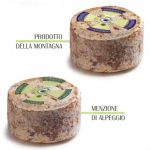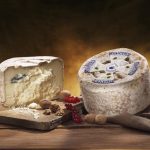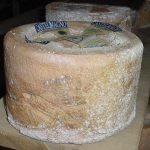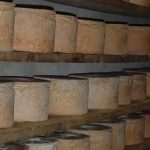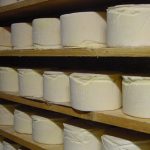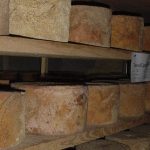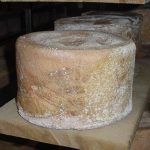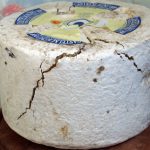
Name
Castelmagno PDO
Seal of quality
Protected Designation of Origin Reg. EEC 1263 dated 01/07/1996.
Description
This cheese comes in a cylindrical form with flat faces measuring 15- 25 cm in diameter, 12- 20 cm circumference and weight ranging from 2 to 7 kg . As for the fresher forms, the rind is thin and a reddish yellow colour, whilst the more matured forms have a wrinkly aspect and are a brownish-ochre. It is a very crumbly cheese without holes and is ivory white, tending towards ochre-yellow with streaks of greenish-blue in the more matured forms. The presence of streaks is due to the development of special moulds, belonging to the pennicillium species, which characterise the “erborinati” (green cheeses) or blue cheeses. “Erborinatura”, a word that comes from the word “erborin” in the Lombardy dialect and means parsley, develops naturally in Castelmagno cheese as it matures, without any need of specific inoculate moulds. Its delicate taste gets stronger and sharper as the maturing season goes on. Authenticity of the product is guaranteed by the mark embossed on each form and stamped at the centre of the characteristic label recalling an Occitan cross.
Castelmagno PDO is produced with cow’s milk and sometimes with sheep and/or goat’s milk with a minimum percentage of 5% to a maximum of 20%.
The milk utilised is obtained by mixing the milk of two milkings, the first of which is kept at a low temperature and skimmed if necessary for surfacing or centrifugation. Coagulation is carried out on raw heated milk in steel boilers up to 35-38° C using liquid rennet. The curd is then broken down to the size of a hazelnut (but in some cases can reach the size of a grain of rice), left to rest under serum for a period ranging from 5 to 30 minutes and, lastly, extracted and wrapped in cloths where they are left to strain for about 24 hours. At the end of this period, the curd is cut into slices and immersed in steel or plastic tanks containing the serum of the processing of that day or of previous processing. The curd is usually left in this serum for 2 or 3 days after having been pulled out and chopped. This chopped curd is then salted with coarse salt, put into plastic or steel moulds and pressed for 24-48 hours in order to facilitate discharge. Maturing, which takes place on natural premises or in cool and humid refrigerators, lasts at least two months.
Nutritional characteristics
Follows the nutritional characteristics of Castelmagno.
| unit of measurement | Castelmagno | |
|---|---|---|
| protein | g/100g | 25.6 |
| Carbohydrates | g/100g | <1 |
| sugar | g/100g | <1 |
| Fat | g/100g | 34,2 |
| di cui saturi | g/100g | 24.6 |
| di cui trans | g/100g | 2.1 |
| cholesterol | Mg/100g | 118 |
| Calcium | mg/kg | 4768 |
| Iron | mg/kg | 7,8 |
| Sodium | mg/kg | 6110 |
| Vit A | mg/kg | 2,4 |
| Vit C | mg/kg | <1 |
| Energy | kcal/100g | 410 |
| KJ | 1700 |
Area of production
Castelmagno PDO can be produced, matured and packed exclusively in the administrative region of the communes of Castelmagno, Pradleves and Monterosso Grana in the province of Cuneo . The milk intended for the processing must also come from the same communes.
Castelmagno can boast the additional mention “Prodotto della montagna” (Mountain product) when the milk production, the processing and the maturing take place in classified areas such as the mountains. If, on the other hand, the cheese is produced and matured in the identified area of production, but at an altitude of over 1000 m , it can bear the mention “di Alpeggio” (from mountain pastures). Both can easily be identified by the colour of the label, blue in the case of “Castelmagno prodotto della montagna” and green in the case of “Castelmagno di alpeggio“.
History
The origins of Castelmagno go way back into the past: it arrived a little later, or at the same time, as Gorgonzola, which was already known in 1100.
Evidence that Castelmagno was already widely known in ancient times can be found in the text of
The arbitration dated 1277 according to which, in order to be able to utilise certain pastures that were object of controversy between the communes of Castelmagno and of Celle di Macra, a yearly sum was established – to be paid to the marquis of Saluzzo – in the form of a certain quantity of Castelmagno cheeses, which were presumably the same as the those produced today.
The 19th century was the golden period of Castelmagno cheese: Castelmagno became the king of Italian cheeses and appeared on the menus of the most famous restaurants of London and Paris . Then came its decline and on the outburst of the wars and with the depopulation of the mountains in the 60s, Castelmagno was seriously in danger of disappearing. Its productive resumption started in the early 80s: Castelmagno obtained national AOC recognition in 1982 and subsequently the European PDO recognition in 1996.
In 2002, the “Consorzio per la Tutela del Castelmagno” was officially recognised, the purpose of which was to promote and protect the cheese of the same name, Castelmagno.



